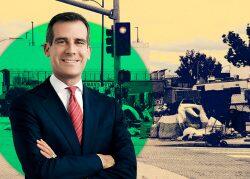Gov. Gavin Newsom has told California cities that until they “do better” to address homelessness, he’ll hold back $1 billion in state funds.
With winter approaching, the governor said he would halt $1 billion for cities and counties until they could prove they have aggressive plans for getting people off the streets, the San Jose Mercury News reported.
The stern rebuke came after the “homeless action plans” required by each jurisdiction failed to pass muster with the governor.
“Californians demand accountability and results, not settling for the status quo,” Newsom said in a statement. “As a state, we are failing to meet the urgency of this moment. … Everyone has to do better — cities, counties and the state included.”
Newsom wants to coordinate a statewide effort to offer substantial results before agreeing to hand out more cash.
Since 2019, the state has set aside more than $2 billion for homeless spending by local agencies, according to the Sacramento Bee.
This summer, however, cities and counties were required to submit action plans as a condition for receiving funding from the state’s Homeless Housing, Assistance and Prevention Program.
The funding available through HHAP is part of $15.3 billion state lawmakers have approved to get 173,000 homeless residents off the streets.
The plans were meant to provide a way for the state to measure how local governments reduce the problem. Newsom noted plans submitted by some cities projected double-digit increases in homelessness over four years.
Collectively, the local plans would reduce street homelessness 2 percent from 2019 to 2024 – an approach Newsom called “unacceptable.”
“At this pace, it would take decades to significantly curb homelessness in California,” he said.
Local officials said cutting off expected state funding would hamper their ability to open shelters. The surprise move to freeze the funding prompted confusion and frustration from the Bay Area to Los Angeles County.
Cities and counties said they need more resources from the state to make a dent in homelessness, with long-term, ongoing resources to solve the crisis.
Oakland’s homeless plan submitted to the state expects the number of people on the street will increase 28 percent between 2020 and 2024, even with the state funds. Officials said earlier this year that it would take $2.5 billion to end homelessness across Alameda County by 2026.
The county was expecting $23 million.
“I share the governor’s urgency to reduce homelessness and always stand ready to meet all accountability measurements,” Oakland Mayor Libby Schaaf told the Chronicle in an email. “However, we are perplexed how delaying HHAP funds advances our shared goals.”
San Francisco had been counting on $47.3 million from the state for the 20,000 residents it expects to become homeless this year. Withholding that funding puts services at risk, including more than 400 shelter beds and a youth drop-in center, a city housing official said.
Graham Knaus, executive director of the California State Association of Counties, called on Newsom to develop a detailed statewide strategy and find an ongoing source of funding, according to the Bee.
Although Newsom earmarked $15 billion over two years for homelessness, the state has no plans for permanent funding to address the problem. That means shelters may close and programs end if cities and counties don’t find funding to sustain them.
“The rate of people experiencing homelessness in California exponentially outpaces our efforts and will continue to do so as long as we continue to act in silos with uncertain funding,” Knaus said in a statement.
Los Angeles Mayor Eric Garcetti said he welcomes the governor’s “ambition to use his bully pulpit” to confront the crisis, but warned that efforts can’t “get mired in more politics and bureaucracy.” The city approved a settlement to spend $3 billion to house the homeless.
“Let me be clear: Any additional delay at the direction of the governor hurts our ability to get Angelenos living on the street into safe and stable housing now,” Garcetti said in a statement. “And this is perplexing, after the city worked directly with and received positive feedback from state agencies and county partners to develop our plan.”
— Dana Bartholomew
Read more


